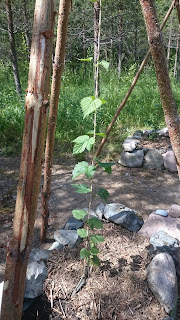This weekend was spent camping with our re-eactment group, on our own little piece of land. I was hugely optimistic when thinking what does one have time to do during one weekend... I took so much stuff with me, but anyway spent most of the weekend dyeing yarn. As a result, we got several really nice dyes and one disappointment too, but that is to be considered as an learning experience -an experiment can't, after all, always turn out to be really splendid.
Eli meillähän oli siis tulilla kuuden padan patteristo, porisemassa verihelttaseitikin jalkoja (kuvassa oranssit ylänarulla), pari viikkoa liotettua koivunlehteä (ylänarulla oikealla), kanervaa (oikealla alanarulla), tammenkuorta soodalla ryyditettynä (takanarulla alhaalla) ja keltahaarakkaita (alanarulla vasemmalla, tämä kuvassa näkyvä tulos saatiin kun haaleaksi jäänyt sieniväri pistettiin kanervaan jälkiväriin). Kuudes oli puretuspata, ihan pelkällä alunalla mentiin. Tammenkuorta kohtaan oli kovat odotukset, sillä liemi oli tosi tummaa ja kauniin punaruskeaa sävyltään (kuten puunkuoret soodalla ovat taipuvaisia olemaan) mutta jostain syystä se ei tarttunut lankoihin oikeastaan lainkaan, tuli lähinnä haaleanbeigeä huuhtomisen ja kuivumisen jälkeen. Aloimme tosin miettiä että olisiko tämä tammenkuoriliemi ollut omimmillaan sittenkin nahan värjäämiseen, mutta se jäi nyt tällä kertaa koittamatta.
So, we had six pots altogether, and on the pots we had cortinarius semisanguineus stipes (on the pic the orange ones on the top clothesline), birch leaves that had been soaked for two weeks (top clothesline, on the right), heather (bottom right clothesline), oak bark with sodium carbonate (back bottom clothesline) and ramaria flava mushrooms (bottom right, they ended up quite lame so this pic is taken after they had been in the heather second dye). The sixth pot was for mordanting, we used only alum. We had really great expectations for the oak bark dyebath, its colour was really dark red-brown, but for some reason it didn't stick and ended up being quite boring beige after the yarns were rinsed and dyed. We started to wonder, though, if it would've been better for dyeing leather, but this is to be tested some other time.
 |
| Viikonlopun värjäyssaldo ~~~ Dyes for the weekend |
Melkoisen hyvä osa ajasta meni myös piipertäessä paikallisella kasvimaalla. Kun kerran oma maapläntti on kyseessä, on sinne vonut aika vapaasti suunnitella omia projekteja ja kasvimaa olikin yksi ensimmäisistä jotka sinne toteutettiin (tosin nykyinen kasvimaa on jo toinen versio ensimmäisen kaaduttua oikeastaan tontin luontaisen hiekkamaaperän sopimattomuuteen useimpien kasvien kasvattamiseen). Kasvimaa tuolla tontilla on koostettu kivellä reunustetuista penkeistä. Yleensähän keskiaikaisissa puutarhan kuvissa kasvimaan penkit on reunustettu laudoilla tai pajupunosaidalla, mutta tuolla meidän kasvimaan paikalla tuota kiveä oli enemmän kuin tarpeeksi ja koska kivipenkitkään eivät ole ihan täysin ennenkuulumattomia, sellaiset sitten laitettiin (luotan tässä tiedossa Medieval garden -kirjaan, kirj. Sylvia Landsberg). Viime vuonna aloitettu kasvimaan täysuudistusprojekti koki hiukan takapakkia talven aikana kun kova talvi tappoi useita kasveja. Tätä vahinkoa sitten tänä vuonna ollaan koitettu ottaa takaisin. Ilmeisen hyvin se onkin onnistunut, ainakin vastatuotu humala oli kasvanut jo parissa viikossa vajaan metrin ja talven tappama lipstikkakin on saanut korvaajan. Useita kertoja paikasta toiseen siirretty pieni ruusukin kukki (ja toinenkin ruusu oli aloittamassa kukintaa), ilmeisesti ensimmäistä kertaa koko tämän kasvimaan historian aikana!
I spent quite a while at the local garden, too. Since the place is owned by the society, we've had quite a lot of freedom to plan whatever we please in there (building regulations considered, of course), and garden was among the very first things that saw the daylight in there. The current version of the garden, though, is the second one because the first failed, mostly due to the natural soil being almost pure sand and therefore really unfitting for almost all garden plants. We built raised benches of stone there. Usually medieval gardens have raised benches of tree planks or wattle, but since we had a really lot of stone there, that's what we used for our benches (and this choice of material is also supported by the book Medieval garden, by Sylvia Landsberg). We started the garden renovation last year, but we experienced some drawbacks because of an especially harsh winter which killed off some of our plants. We've tried to repair the damage, and apparently we've suceeded since newly planted hops are growing like mad! Also, a small rose bush which has been moved form one place to another several times has started to make flowers, this is its first time ever in this garden!
Ja sitten viikon kuva-arvoitus, mihin tässä on ainekset? No, ei pidetä jännityksessä, mutta jos ehdit katsoa että pystykangaspuihin siinä voisi olla potentiaalia, niin olit ihan oikeassa. Tosin vastakaadettuina ne joutuvat kuivumaan vielä tovin jos toisenkin, ja varmaan pystypuita joutuu vielä hiukan lyhentämään... Ovat nyt puuvajassa kuivumassa ja ensi keväällä sitten niitä pääsee käpistelemään enemmän sitten.
And then, the quiz for this week: what are these going to be? Ok, I'm not going to keep you wondering, but just in case you saw them as having potential to become an upright loom, you were absolutely right. They're newly felled, though, so they'll have to dry for a while, and I'll probably have to adjust the measurements some too. For now, they're patiently waiting at the woodshed..





No comments:
Post a Comment